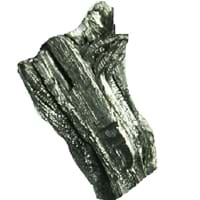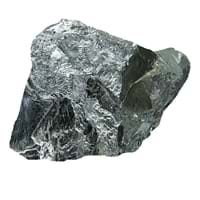Dysprosium vs Chromium
Periodic Table
Symbol
Dy
Cr
Group Number
Not Available
6
12
Period Number
6
4
Block
f block
d block
Element Family
Lanthanide
Transition Metal
CAS Number
7429916
99+
7440473
39
Space Group Name
P63/mmc
Im_ 3m
Space Group Number
194.00
5
229.00
1
Facts
Interesting Facts
- Dysprosium acts stable in air at room temperature.
- Dysprosium behaves very much like paramagnetic metal.
- Chromium is highly reactive, hence it is not found free in nature.
- Ores of Chromites mineral are the major source of Chromium metal.
- Almost 90% leather tanning is done with the help of chromium.
Sources
Found in Minerals, Mining, Ores of Minerals
Found in Minerals, Mining, Ores of metals, Ores of Minerals
History
Who Discovered
Lecoq de Boisbaudran
Louis Nicolas Vauquelin
Discovery
In 1886
In Between 1797 - 1798
Abundance
Abundance In Universe
2 * 10-7 %
22
1.5 * 10-3 %
7
Abundance In Sun
~0.0000002 %
25
~0.002 %
7
Abundance In Meteorites
0.00 %
33
0.30 %
7
Abundance In Earth's Crust
0.00 %
28
0.01 %
13
Abundance In Oceans
0.00 %
35
0.00 %
16
Abundance In Humans
Not Available
0.00 %
16
Uses
Uses & Benefits
- Dysprosium metal is highly reactive due to which it pure form is not as usual as its alloy.
- Thi metals alloy is used in magnate as it is resistance to high temperature.
- It is used to harden the steel and produces a stainless steel and other various alloys.
- It is also used to give proper finish to polished mirrors. Its chromium plates are used in bathroom fittings.
Industrial Uses
NA
Automobile Industry, Chemical Industry
Medical Uses
NA
NA
Other Uses
Alloys, Nuclear Research
Alloys
Biological Properties
Toxicity
Mildly Toxic
Highly Toxic
Present in Human Body
No
Yes
In Blood
Not Available
0.11 Blood/mg dm-3
12
In Bone
Not Available
0.33 p.p.m.
21
Physical Properties
Melting Point
1,407.00 °C
32
1,857.00 °C
14
Boiling Point
2,562.00 °C
99+
2,672.00 °C
39
Appearance
Physical State
Solid
Solid
Color
Silvery White
Silver
Luster
Metallic
Metallic
Hardness
Mohs Hardness
Not Available
8.50
1
Brinell Hardness
500.00 MPa
23
687.00 MPa
16
Vickers Hardness
540.00 MPa
20
1,060.00 MPa
10
Speed of Sound
2,710.00 m/s
33
5,940.00 m/s
5
Optical Properties
Allotropes
No
No
α Allotropes
Not Available
Not Available
β Allotropes
Not Available
Not Available
γ Allotropes
Not Available
Not Available
Chemical Properties
Chemical Formula
Dy
Cr
Isotopes
Known Isotopes
29
10
21
18
Electronegativity
Pauling Electronegativity
1.22
38
1.66
18
Sanderson Electronegativity
Not Available
1.66
14
Allred Rochow Electronegativity
1.10
30
1.56
10
Allen Electronegativity
Not Available
1.65
19
Electropositivity
Pauling Electropositivity
2.78
16
2.34
36
Ionization Energies
1st Energy Level
573.00 kJ/mol
99+
26,130.00 kJ/mol
1
2nd Energy Level
1,130.00 kJ/mol
99+
28,750.00 kJ/mol
1
3rd Energy Level
2,200.00 kJ/mol
99+
34,230.00 kJ/mol
1
4th Energy Level
3,990.00 kJ/mol
37
37,066.00 kJ/mol
1
5th Energy Level
Not Available
97,510.00 kJ/mol
1
6th Energy Level
Not Available
105,800.00 kJ/mol
1
7th Energy level
Not Available
114,300.00 kJ/mol
1
8th Energy Level
Not Available
125,300.00 kJ/mol
1
9th Energy Level
Not Available
134,700.00 kJ/mol
1
10th Energy Level
Not Available
144,300.00 kJ/mol
1
11th Energy Level
Not Available
26,130.00 kJ/mol
12
12th Energy Level
Not Available
28,750.00 kJ/mol
13
13th Energy Level
Not Available
34,230.00 kJ/mol
10
14th Energy Level
Not Available
37,066.00 kJ/mol
12
15th Energy Level
Not Available
97,510.00 kJ/mol
1
16th Energy Level
Not Available
105,800.00 kJ/mol
2
17th Energy Level
Not Available
114,300.00 kJ/mol
3
18th Energy Level
Not Available
125,300.00 kJ/mol
4
19th Energy Level
Not Available
134,700.00 kJ/mol
5
20th Energy Level
Not Available
144,300.00 kJ/mol
7
21st Energy Level
Not Available
157,700.00 kJ/mol
7
22nd Energy Level
Not Available
166,090.00 kJ/mol
6
Electrochemical Equivalent
2.02 g/amp-hr
29
0.32 g/amp-hr
99+
Electron Work Function
Not Available
4.50 eV
14
Other Chemical Properties
Anti Corrosion, Ionization, Radioactive Isotopes, Solubility
Anti Corrosion, Chemical Stability, Ionization, Radioactive Isotopes, Solubility
Atomic Properties
Atomic Number
66
99+
24
99+
Electron Configuration
[Xe] 4f9 6s2
[Ar] 3d5 4s1
Crystal Structure
Hexagonal Close Packed (HCP)
Body Centered Cubic (BCC)
Crystal Lattice
HCP-Crystal-Structure-of-Dysprosium.jpg#100
BCC-Crystal-Structure-.jpg#100
Atom
Number of Protons
66
99+
24
99+
Number of Neutrons
96
35
28
99+
Number of Electrons
66
99+
24
99+
Radius of an Atom
Atomic Radius
178.00 pm
16
128.00 pm
99+
Covalent Radius
192.00 pm
17
139.00 pm
99+
Van der Waals Radius
229.00 pm
20
200.00 pm
28
Atomic Weight
162.50 amu
99+
52.00 amu
99+
Atomic Volume
19.00 cm3/mol
23
7.23 cm3/mol
99+
Adjacent Atomic Numbers
Valence Electron Potential
47.40 (-eV)
32
170.00 (-eV)
4
Lattice Constant
359.30 pm
37
291.00 pm
99+
Lattice Angles
π/2, π/2, 2 π/3
π/2, π/2, π/2
Lattice C/A Ratio
1.57
15
Not Available
Mechanical Properties
Density
Density At Room Temperature
8.54 g/cm3
99+
7.19 g/cm3
99+
Density When Liquid (at m.p.)
8.37 g/cm3
25
6.30 g/cm3
40
Tensile Strength
120.00 MPa
15
689.00 MPa
7
Viscosity
Not Available
Not Available
Vapor Pressure
Vapor Pressure at 1000 K
Not Available
0.00 (Pa)
24
Vapor Pressure at 2000 K
Not Available
774.00 (Pa)
1
Elasticity properties
Shear Modulus
24.70 GPa
31
115.00 GPa
9
Bulk Modulus
40.50 GPa
31
160.00 GPa
11
Young's Modulus
61.40 GPa
33
279.00 GPa
8
Poisson Ratio
0.25
25
0.21
32
Other Mechanical Properties
Sectile
NA
Magnetic Properties
Magnetic Characteristics
Specific Gravity
8.55
38
7.19
99+
Magnetic Ordering
Paramagnetic
Antiferromagnetic
Electrical Properties
Electrical Property
Conductor
NA
Resistivity
926.00 nΩ·m
2
125.00 nΩ·m
27
Electrical Conductivity
0.01 106/cm Ω
99+
0.08 106/cm Ω
25
Electron Affinity
50.00 kJ/mol
21
64.30 kJ/mol
15
Thermal Properties
Specific Heat
0.17 J/(kg K)
34
0.45 J/(kg K)
12
Molar Heat Capacity
27.70 J/mol·K
14
23.35 J/mol·K
99+
Thermal Conductivity
10.70 W/m·K
99+
93.90 W/m·K
17
Critical Temperature
Not Available
Not Available
Thermal Expansion
9.90 µm/(m·K)
40
4.90 µm/(m·K)
99+
Enthalpy
Enthalpy of Vaporization
230.00 kJ/mol
39
348.80 kJ/mol
24
Enthalpy of Fusion
11.05 kJ/mol
32
15.31 kJ/mol
20
Enthalpy of Atomization
301.00 kJ/mol
36
397.50 kJ/mol
21
Standard Molar Entropy
75.60 J/mol.K
7
23.80 J/mol.K
99+
|
||
|
||
|












